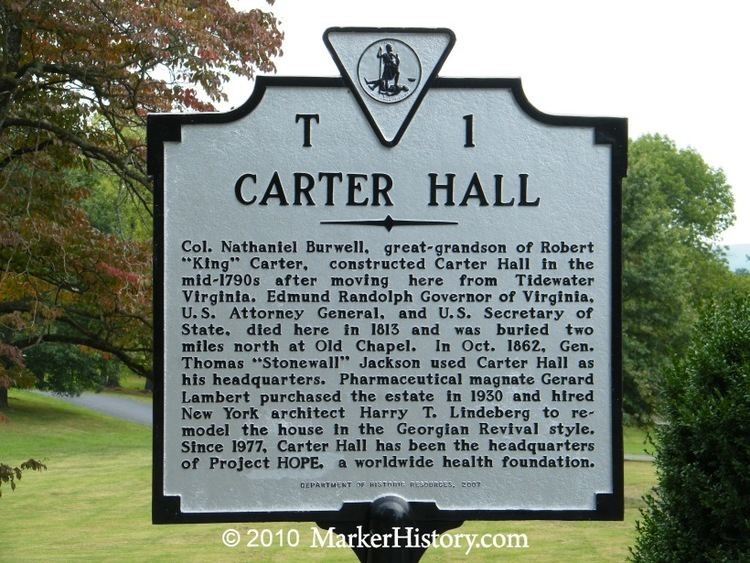Built 1792 VLR # 021-0012 Opened 1792 Architect Harrie T. Lindeberg | NRHP Reference # 73002003 Designated VLR June 19, 1973 Area 36 ha Added to NRHP 24 July 1973 | |
 | ||
Similar Old Chapel, Burwell‑Morgan Mill, Carter's Grove, Long Branch, Greenway Court | ||
Carter Hall was the Millwood, Virginia, USA estate of Lt. Col. Nathaniel Burwell (1750–1814). It is located in the upper Shenandoah Valley, off Virginia Route 255 northeast of Millwood. The estate includes a grand plantation house, a great lawn, and terraced gardens, and has panoramic views in all directions. It is listed on the National Register of Historic Places.
Nathaniel Burwell inherited a 5,800-acre (2,347 ha) estate from his father Carter Burwell, of Carter's Grove, James City County, and had a mansion built during 1792–1800.
George Burwell (1799–1873) inherited the estate in 1814 and added the large portico, which is "by tradition" ascribed to a design of William Thornton, architect of the United States Capitol.
It served as headquarters for Stonewall Jackson during part of the American Civil War, and was raided and sacked by Union troops during the war. Stonewall Jackson used another house, in Lexington, Virginia, as headquarters during 1861–1862, and later established headquarters at Carter Hall during Fall of 1862. Jackson "declined George Burwell's invitation to stay in the house, camping instead with his men on the grounds. During his stay General Jackson permitted his surgeon, Dr. William McGuire, to perform a cataract operation on George Burwell on the portico."
It was also a home for Burwell's cousin Edmund Randolph, who had been United States Attorney General and later Secretary of State under George Washington, and was invited to pass his retirement with Colonel Burwell.
Carter Hall has a five-bay central block built of local limestone, originally with a central hall flanked by rooms extending the full depth of the house (single-pile plan). The flanking two-bay wings have pediment gable ends and the outermost, single-story wings are of a single bay, formerly with pediment ends.
The house was remodeled in 1930 for its new owner Gerard Lambert "under the direction of the fashionable New York architect, H.T. Lindeberg," and a four-level terraced garden designed by landscape architect Wade Muldoon was added in 1948. The stucco was removed from the exterior to expose the stone. In the house the central hall and east room were combined into a single space and the original wainscoting was replaced with richly-detailed neo-Georgian details based on woodwork at Shirley Plantation, Virginia. The dining room is the only room to retain significant portions of its original fittings.
Carter Hall was listed on the National Register of Historic Places in 1973.
It is now a conference center owned by Project Hope.
